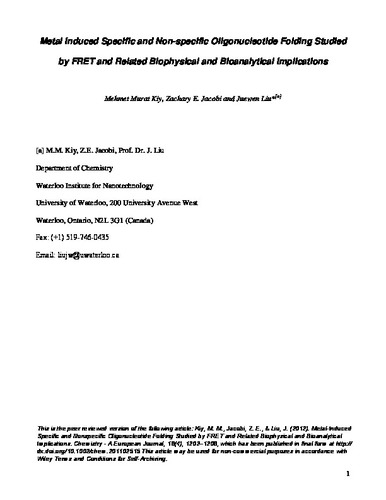| dc.contributor.author | Kiy, Mehmet Murat | |
| dc.contributor.author | Jacobi, Zachary E. | |
| dc.contributor.author | Liu, Juewen | |
| dc.date.accessioned | 2017-03-01 18:16:56 (GMT) | |
| dc.date.available | 2017-03-01 18:16:56 (GMT) | |
| dc.date.issued | 2012-01-13 | |
| dc.identifier.uri | http://dx.doi.org/10.1002/chem.201102515 | |
| dc.identifier.uri | http://hdl.handle.net/10012/11400 | |
| dc.description | This is the peer reviewed version of the following article: Kiy, M. M., Jacobi, Z. E., & Liu, J. (2012). Metal-Induced Specific and Nonspecific Oligonucleotide Folding Studied by FRET and Related Biophysical and Bioanalytical Implications. Chemistry - A European Journal, 18(4), 1202–1208, which has been published in final form at http://dx.doi.org/10.1002/chem.201102515 This article may be used for non-commercial purposes in accordance with Wiley Terms and Conditions for Self-Archiving. | en |
| dc.description.abstract | Metal induced nucleic acid folding has been extensively studied with ribozymes, DNAzymes, tRNA and riboswitches. These RNA/DNA molecules usually have a high content of double-stranded regions to support a rigid scaffold. On the other hand, such rigid structural features are not available for many in vitro selected or rationally designed DNA aptamers; they adopt flexible random coil structures in the absence of target molecules. Upon target binding, these aptamers adaptively fold into a compact structure with a reduced end-to-end distance, making fluorescence resonance energy transfer (FRET) a popular signaling mechanism. However, nonspecific folding induced by mono- or divalent metal ions can also reduce the end-to-end distance and thus lead to false positive results. In this study we used a FRET pair labeled HgII binding DNA and monitored metal-induced folding in the presence of various cations. While nonspecific electrostatically mediated folding can be very significant, at each tested salt condition, HgII induced folding was still observed with a similar sensitivity. We also studied the biophysical meaning of the acceptor/donor fluorescence ratio that allowed us to explain the experimental observations. Potential solutions for this ionic strength problem have been discussed. For example, probes designed to signal the formation of double-stranded DNA showed a lower dependency on ionic strength. | en |
| dc.description.sponsorship | University of Waterloo ||
Canadian Foundation for Innovation
Ontario ministry of Research and Innovation ||
Natural Sciences and Engineering Research Council || | en |
| dc.language.iso | en | en |
| dc.publisher | Wiley | en |
| dc.subject | DNA | en |
| dc.subject | FRET | en |
| dc.subject | mercury | en |
| dc.subject | folding | en |
| dc.subject | cations | en |
| dc.title | Metal-Induced Specific and Nonspecific Oligonucleotide Folding Studied by FRET and Related Biophysical and Bioanalytical Implications | en |
| dc.type | Article | en |
| dcterms.bibliographicCitation | Kiy, M. M., Jacobi, Z. E. and Liu, J. (2012), Metal-Induced Specific and Nonspecific Oligonucleotide Folding Studied by FRET and Related Biophysical and Bioanalytical Implications. Chem. Eur. J., 18: 1202–1208. doi:10.1002/chem.201102515 | en |
| uws.contributor.affiliation1 | Faculty of Science | en |
| uws.contributor.affiliation2 | Chemistry | en |
| uws.contributor.affiliation2 | Waterloo Institute for Nanotechnology (WIN) | en |
| uws.typeOfResource | Text | en |
| uws.peerReviewStatus | Reviewed | en |
| uws.scholarLevel | Faculty | en |

